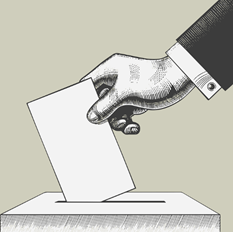
Of all the complexities of federal and state election laws, Michigan has surprisingly simple and straight-forward processes for dealing with candidates that receive an even number of votes for a particular office. The type of process to be used depends on the office being sought.
The Michigan Board of State Canvassers has the duty of canvassing the returns and determining the result of all elections for electors of President and Vice-President of the United States, state officers (e.g. governor, lieutenant governor, attorney general, secretary of state), U.S. senators, U.S. representatives, circuit court judges, state senators and representatives elected to a district located in more than one county, and other offices as determined by law. Of course, this body can only determine which presidential/vice-presidential candidate carried the State of Michigan, not the entire country, for the purposes of determining which political party’s electors are pledged to the United States Electoral College. The Michigan Board of State Canvassers also determines the result in an election on a proposed amendment to the constitution or any ballot question proposed to the state voters at large.
In the event of a tie vote, MCL 168.846 provides the follows:
- “In case 2 or more persons have an equal and the highest number of votes for any office, as canvassed by the board of state canvassers, the board of state canvassers shall certify the result of the canvass as to such office to the legislature and the legislature in joint convention shall choose 1 of said persons to fill such office. When the determination of the board of state canvassers is contested, the legislature in joint convention shall decide which person is elected.”
So, in the event of a tie, the Michigan Legislature (with both house acting in a joint convention) gets to pick the winner. This is not dissimilar to the U.S. Constitution provision that, if the Electoral College is unable to elect the president and vice-president, the election is decided by the U.S. House of Representatives. The Legislature’s selection of the winner in a tie can depend heavily on the current political climate within both houses. Fortunately, the mathematical possibility of a tie in the popular vote for a statewide office is extremely slim.
The board of county canvassers has the duty of canvassing the returns and determining the result of all elections for district court judges, probate court judges, state senators and representatives elected to a district wholly contained within one county, countywide offices (e.g. county clerk, sheriff, prosecutor, treasurer), and township offices (e.g. supervisor, clerk, trustees). In many county elections, the turnout is often hundreds of voters and matters can be determined by a very slim margin of votes, increasing the chances that a tie can occur.
In the event of a tie vote, MCL 168.851 provides the follows:
- “If it shall appear on the canvass of the votes polled at any election canvassed by the board of county canvassers that 2 or more persons have received an equal number of votes for the same office, and that a failure to elect to any office is caused thereby, the election to the office shall be determined in the following manner: The board of canvassers for the county in which such election was held shall appoint a day for the appearance of all affected persons before the county clerk for the purpose of determining by lot among such persons the right to the office, and shall cause notice thereof to be given to all the persons interested. The county clerk shall prepare as many slips of paper as there are such persons, and write the word “elected” on as many slips of paper as there are offices to be filled, and the words “not elected” on the remaining slips, and fold the same so as to conceal the writing and so that they may appear as near alike as possible. The slips shall be placed in a box and, at the time and place appointed for the drawing of the lots, each of the persons aforesaid may draw 1 of the slips from the box, and any person drawing a slip on which is written the word “elected” shall be deemed legally elected to the office in question and the county clerk shall forthwith give him a certificate of election. The county clerk may appoint any person present to draw a slip for any affected person who fails to appear at the time specified in the notice. If the office of county clerk is in question, the drawing shall take place before the sheriff of the county. Such determination, however, shall not preclude the right of a defeated candidate to a recount of the votes cast as provided in chapter 36.”
In December 2000, the election for Fife Lake Township supervisor was tied at 297 votes for both candidates. To settle the election, the candidates met at the county clerk’s office where they would draw from a box holding two slips of paper, one that read “elected” and one that read “not elected”. Prior to the drawing, the county clerk flipped a coin to determine which candidate would draw from the box. The non-incumbent candidate won the coin toss and happened to draw the piece of paper from the box that declared her the winner. The losing candidate did not elect to petition for a recount, although it was in his right to do so.
As unsettling as it may be to resolve a political election by chance with the drawing of lots, it has one advantage that is consistent with the values of a democratic society: it’s fair.





